#18th c. netherlands
Text
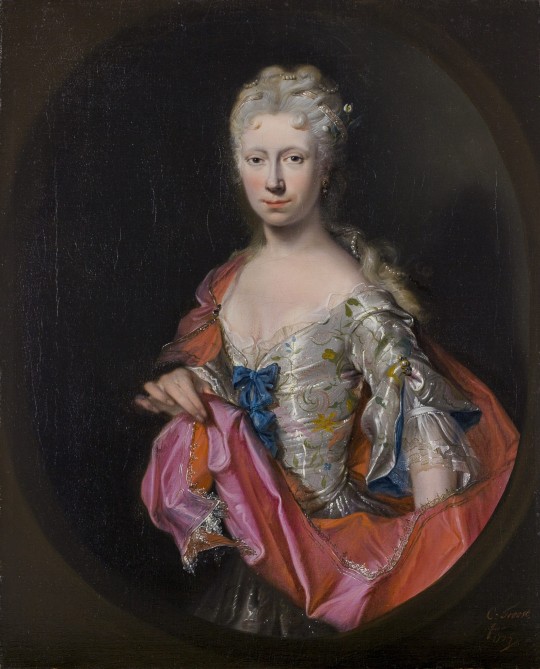
Portrait of a lady by Cornelis Troost, 1725
45 notes
·
View notes
Photo

Charles Hodges - self portrait, c.1830
Charles Howard Hodges was a British painter active in the Netherlands during the French occupation of the 18th and early 19th century.
8 notes
·
View notes
Note
I mean, we don't know how Quincey and Van Helsing got their money, hey are both from different countries like Dracula but they probably didn't wage war to get them.
I like looking at Van Helsing, Dracula and Quincey Morris together as Outsiders to the British Empire, it always gets interesting because you turn up a lot of foils/parallels/double standards/weird coincidences.
Rules don't seem to apply to Van Helsing, which I think is because he isn't a man so much as a sage and a conduit for exposition. He keeps multiple doctorates tucked up his sleeves, has contacts in Dutch flower markets, experimental medicine and folklore, and can dart back and forth between London and the Netherlands on a nightly basis with no consideration to the cost. He's very very weird and tailor-made for the circumstance he is in, which requires money being no obstacle. He's a being of imagination, knowledge, truth etc. Things like how he pays for his train tickets are too base and material to matter to him. The Count needs money and the British defenders (Jonathan, Arthur et al) need money because they are in an imperial conflict that has to be funded. Van Helsing, however, has flitted into the situation with the currency of wisdom.
(Side note: Dutch colonialism. I'd assume that ultimately, Van Helsing's wealth comes from the same place as Arthur's (and the Count's). so yeah, kind of by waging war. it's also interesting to consider the fact that the British empire had taken control of swathes of Dutch colonies in the 18th c into the 19th, including a buyout the Dutch gold coast in the 1870s. It's not a perfect reading but I'd argue something along the lines that Van Helsing and the information (and garlic flowers) he is exporting to the men in Dracula make up a similar shift of power and ceding of territory. Arthur, as British empire, is bankroll and Van Helsing, as Dutch territory, is trade and resources)
Then there's Quincey Morris. I'm going to be as ambiguous as possible for now, but I will say a couple of things:
It's not unfair to guess that Stoker's attitude towards Quincey changed at least once during writing based on the manuscript and different editions, and he creates some weird textual issues
Quincey's primary function in a lot of ways is to be From The Frontier
Quincey's past provides more questions than answers
Quincey Morris is never asleep when everyone else needs to be woken up
#dracula daily#ty for the ask!!#i will come back to Quincey when we're done i think because there are some readings i dont necessarily buy but find very cool anyway#if youre aware of the Thing with Quincey Morris please tell me though because it would be fun to discuss
21 notes
·
View notes
Text
The Netherlands said Thursday it will hand back hundreds of colonial-era artifacts to Indonesia and Sri Lanka, including a haul of treasure and a gem-encrusted bronze cannon.
The decision to return some 478 objects followed recommendations by a government-appointed commission last year looking into illegal Dutch colonial acquisitions now being displayed in museums in the Netherlands.
"These recommendations are a milestone in dealing with collections from a colonial context," said Gunay Uslu, Dutch deputy minister for culture, education and science.
The commission was set up after a request by Indonesia for the return of some art pieces and natural history collections by its former colonial ruler the Netherlands.
Some of the items to be handed back include the so-called "Lombok treasure" of hundreds of golden and silver objects, looted by the Dutch colonial army after capturing the Cakranegara palace on Indonesia's Lombok island in 1894.
It also included a bronze cannon decorated with silver, gold and precious gems including rubies. The 18th-century "Lewke's cannon" is believed to have been a gift by a Sri Lankan aristocrat called Lewke Disava to the king of Kandy around 1745-1746.
It is believed to have fallen into Dutch hands in 1765 when Dutch troops led by the governor of Ceylon Lubbert Jan van Eck attacked and conquered Kandy.
After being displayed around the Netherlands, the cannon was eventually added to the Rijksmuseum's collection in Amsterdam. Rijksmuseum director Taco Dibbits said the "restitution as a positive step in cooperation with Sri Lanka."
"The relationship and exchanges of knowledge built up between the two nations in the fields of research and common history constitute a strong foundation for the future," he added in a statement.
The commission will hand down decisions about other artifacts in the future, public broadcaster NOS said.
This included art from Nigeria as well as the Dubois collection which included the horse-riding reins of Prince Diponegoro, a Javanese royal who opposed Dutch colonial rule in the 19th century.
The Netherlands has been wrestling with the legacy of its colonial past in recent years.
Dutch King Willem-Alexander on Saturday issued a historic royal apology for the Netherlands' involvement in colonial-era slavery.
4 notes
·
View notes
Photo

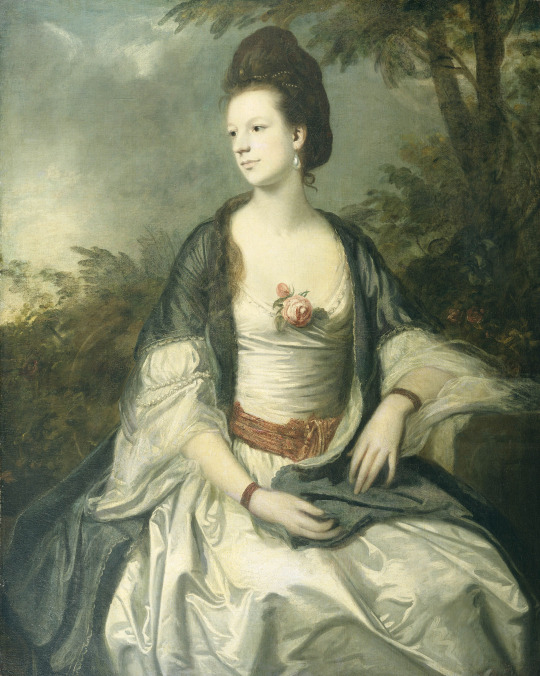


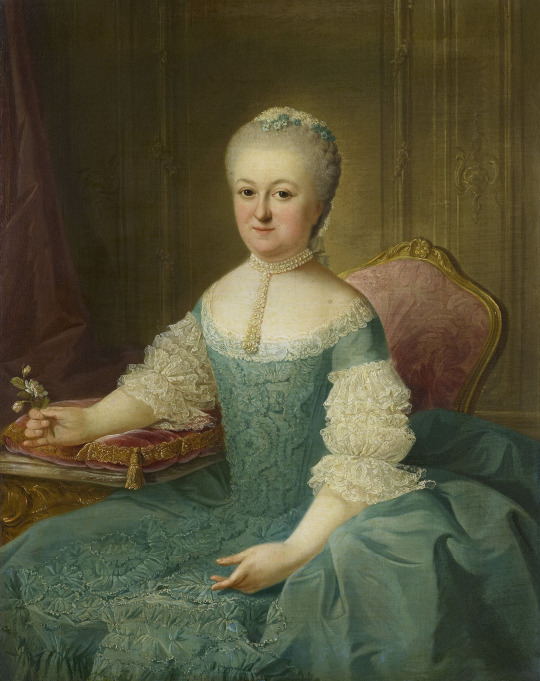

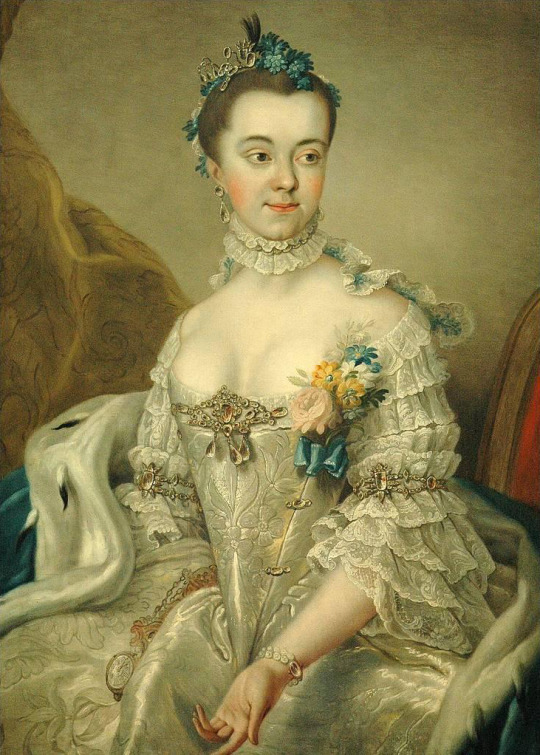
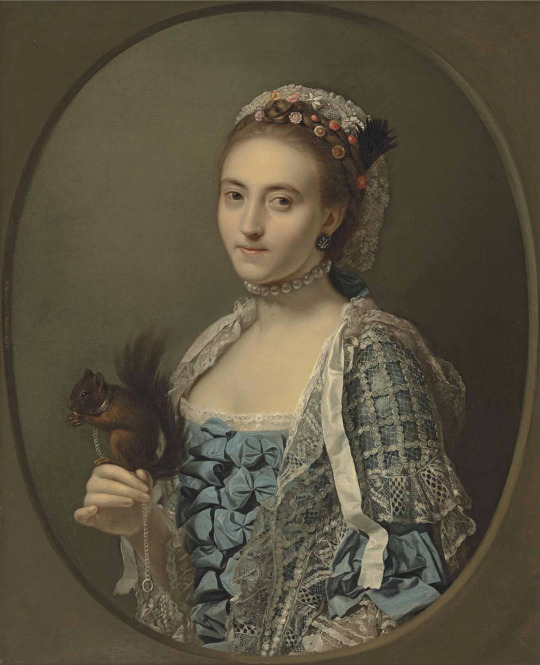

On to 1762 -
Top left: ca. 1762 Elizabeth Rushout (c.1730–1772), Mrs Myddleton by Francis Cotes (Chirk Castle - Chirk, Wrexham/Wrecsam, Wales, UK). From cutlermiles.com/elizabeth-rushout-francis-cotes-r-a-francis-cotes-r-a/ 1006X1280 @72 314kj.
Top right: 1762 Lady Cecil Rice by Sir Joshua Reynolds (Frick Collection - New York City, New York, USA). From Wikimedia 3200X4006 @72 4.5Mj.
Second row: ca. 1762 Lady Alston by Thomas Gainsborough (Louvre). From wga.hu/html_m/g/gainsbor/040alsto.html; enlarged to fit screen & filled shadows 40% 1872X2542 @144 6.7Mp.
Third row left: 1762 Mrs. Robert Froude, née Phillis Hurrell by Sir Joshua Reynolds (Minneapolis Institute of Art - Minneapolis, Minnesota, USA). From their Web site via pinterest.com/NevaKoda/18th-century-adoration/ 2130X2730 @72 1.8Mj.
Third row right: 1762 Lady from the van de Poll Family, possibly Anna Maria Dedel, Wife of Jan van de Poll by Guillaume de Spinny (Rijksmuseum - Amsterdam, Netherlands). From their Web site; erased obvious spots & cracks w Pshop 2888X3590 @72 4.1Mj.
Fourth row: 1762 Madame Sophie de France (1734–1782) with a fur muff by François-Hubert Drouais (Metropolitan Museum of Art). From Wikimedia 3151X3890 @150 4.7Mj.
Fifth row left: 1762 Herzogin Charlotte Amalie Wilhelmine von Holstein-Sonderburg-Plön by Stefan Torelli (location ?). From fripperiesandfobs.tumblr.com/image/13279211821 731X1022 @72 427kj.
Fifth row right: 1762 Olive Craster (d. 1769), half-length, in a blue dress with ribbons and a lace shawl, with a pearl necklace and flowers in her hair, holding a squirrel by Sir Nathaniel Dance-Holland (auctioned by Christie's). From their Web site 3369X4151 @150 8M.
Sixth row: 1762 Sofia Charlotta, Princess Mecklenburg-Strelitz, Queen of England by Georg David Matthieu (Nationalmuseum - Stockholm) From the-athenaeum.org 726X1024 @300 255kj.
#1762 fashion#Georgian fashion#Louis XV fashion#Rococo fashion#Elizabeth Rushout#Francis Cotes#high coiffure#British casual dress#Lady Cecil Rice#Joshua Reynolds#cross over bodice#Lady Alston#Thomas Gainsborough#engageantes#Phillis Hurrell#jacket#Anna Maria Dedel#Guillaume de Spinny#off shoulder scoop neckline#Madame Sophie#François-Hubert Drouais#fur muff#Charlotte Amalie Wilhelmine von Holstein-Sonderburg-Plön#Stefan Torelli#lace neck band#Olive Crasterm#Nathaniel Dance-Holland#Queen Charlotte#Georg David Matthieu
16 notes
·
View notes
Text
Dutch Empire: 4. East Indies
The Dutch East Indian Empire spans two periods: the first, between c.1602 and 1795, coincides with the life span of the Dutch East India Company (VOC) and covers the territories and settlements across Asia controlled by the company. The second period, between c.1815 and 1949, focuses on the Dutch East Indies, which emerged after World War II substantially as the Republic of Indonesia.
The history of the Dutch East Indian Empire can be divided into two periods that are demarcated by a transitional regime during Europe's revolutionary wars at the turn of the 18th and 19th centuries. The first period coincides with the life span of the United Dutch East India Company, a chartered corporation better known by its historic initials VOC (for Vereenigde Oostindische Compagnie). This covers the period between the formation of the company in 1602 and its bankruptcy in 1795. Its assets were subsequently taken over by the state, and the VOC was dissolved in 1799. At its apex, the settlements or areas effectively controlled by the Dutch company spanned the Indian Ocean and Western Pacific regions from the Cape of Good Hope to the Deshima factory in Japan.
The second major period covers about one and a half centuries between the end of the Napoleonic Wars (1815) and the end of World War II (1945). In this period, the Dutch focused on a part of insular Southeast Asia that would later become known as Indonesia. This second period of Dutch rule was interrupted by the Japanese Occupation between 1942 and 1945, and the Dutch briefly sought to resume rule until 1949. The western area of the island of New Guinea, known today as West Papua, however, continued to be ruled by the Netherlands until 1963.
The VOC period, c.1600–1800
To better appreciate Dutch patterns of political and commercial expansion across Asia during the late 16th and early 17th centuries, it is best to delve a bit deeper into the events that were unfolding in Europe in this period. There are three broader developments worth mentioning. First, the Reformation had engulfed the major political powers of Western and Central Europe for much of the 16th and 17th centuries. Serious disturbances were also felt in the Low Countries, which, in the second half of the 16th century, were ruled by Philip II as their hereditary ruler. Philip's effort to stamp out Protestantism and roll back Protestant influences across Central and Western Europe at large was a major contributing factor in unleashing a political struggle in the Netherlands against its overlord Spain known as the Dutch Revolt. Second, the Act of Abjuration in 1581 paved the way for the birth of the Dutch Republic, formed of seven provinces located in the north, while the remaining ten provinces located in the south were eventually reconciled with their Spanish ruler and became known as the Spanish (and later as the Austrian) Netherlands. Though the seven provinces (the United Provinces, the Dutch Republic) were not formally recognized as an independent state until 1648, the war with Spain that continued from 1581 to 1648 was not confined to the European theater, but was brought to the far corners of the globe, including the East Indies. Third, an additional twist to the conflict came with the Portuguese succession crisis of 1580–1581, when Philip II of Spain claimed the Portuguese throne and was subsequently confirmed as the kingdom's hereditary ruler. After 1581 the union of the crowns of Spain and Portugal marked the beginning of six decades of Spanish Habsburg rule over Europe's two early world empires.
When trading restrictions were imposed by the Spanish and the Portuguese on Dutch merchants on the Iberian Peninsula, the Dutch began to also extend the war to the Portuguese. This war would fundamentally shape Dutch relations with the Iberian powers well into the first half of the 17th century, and arguably even beyond.
The first Dutch voyages to the East Indies (1595–1602) had been conducted under the auspices of several smaller ventures known collectively as the voorcompagnieën (Predecessor Companies). Early euphoria about direct Dutch trade with the East Indies, however, quickly waned. Within a few years it had become evident that Dutch commerce with Asia was threatened by heightened competition between the Predecessor Companies and the erosion of profits reaped from the importation of spices into the Republic. It is widely accepted that government intervention induced the merger of six Predecessor Companies to form the VOC. The merged entity was characterized by a common balance sheet and a common board of directors known as the Gentlemen XVII.
From the start the VOC was granted a charter for 21 years and a monopoly of trade with the Republic east of the Cape of Good Hope. Characteristic of the Dutch company were the quasi-sovereign powers devolved to it from the States General (the Dutch Republic's federal “parliament”): the charter granted the company the right to sign treaties, hire soldiers, declare war and conclude peace, mint coins, pass laws, and pronounce justice. With hindsight these quasi-sovereign powers arguably added to the longevity of the VOC. In the early years the company had one very special function: it was to serve as the self-financing arm of the Dutch war effort against Spain and Portugal in its charter area. Backed by resolutions of the States General, the first two decades of the VOC's corporate life span were characterized by attacking Iberian targets, forging numerous anti-Iberian alliances with Asian rulers, and investing heavily in military as well as business infrastructure.
Two changes in the way the company conducted and organized itself in Asia set the VOC on its path to becoming an agent or instrument of empire. First was the appointment of a governor general who took up residence in Asia and was supported in his deliberations and actions by the Raad van Indië (Council of India). Pieter Both was the first governor general and took up residence in Southeast Asia just as the Twelve Years Truce (1609–1621) between the Dutch Republic and the Iberian empires was scheduled to take effect east of the Cape of Good Hope (April 1610). The second change arose from several logistical problems faced by the early fleet commanders in waging war on the Iberians or sourcing for spices and other trading goods across Asia. Due to the lack of available stocks, ships often had to wait for the next harvest of spices, thus increasing turnaround time and costs. Besides, by the time ships arrived in the East Indies on their long voyage from Europe, the men were physically not in a condition to engage the Iberian enemy in combat. By contrast, the Iberians at the time could rely on their key centers in Goa and Manila and in any case commanded over shorter lines of supply and communication. To overcome these commercial and military obstacles, it was deemed necessary to select a place to found a permanent base in Asia where the VOC could concentrate its operations, offer support services to ships and crews, and construct warehouses to store goods between voyages. Initially, the Portuguese-held port and colony of Malacca appears to have been the preferred location for the VOC's Asian base, but growing experience with monsoon winds, currents, and seasons, as well as the geopolitical and geostrategic situation at large, led early fleet commanders like Admiral Cornelis Matelieff de Jonge to prefer a location in West Java near the Sunda Strait. He explained his choice based upon the following considerations: due to its geographic location and exposure to the monsoon winds, Malacca could not be accessed from all directions throughout the year. By contrast, the region around the Sunda Strait was much better situated, especially for arrivals from and departures for Europe. This region could be accessed at any time of the year and had a hinterland that provided ample supplies of food. A permanent base near the Sunda Strait backed by warehousing and support facilities enabled a shorter turnaround time for vessels and thus also saved costs.
Although Matelieff personally singled out and favored Jayakarta (also Sunda Kelapa or Jacatra) as the preferred location for the VOC's Asian base around 1608, it was not until a decade later that the settlement came to assume this role. Jayakarta's ruler entered into problematic dealings with both the Dutch and English East India companies, resulting in armed conflict and, ultimately, the Dutch conquest of the settlement. The town and some surrounding territory became a Dutch possession and was renamed Batavia in 1619.
Four additional developments enhanced the longevity of the VOC and with it laid the cornerstones of the first Dutch Empire in the East Indies. The first consisted of wresting colonies from Iberian rule and control. The first colony to be acquired by the VOC proper was the settlement and island of Ambon, which was seized in a bloodless takeover in 1605. More ports and colonies were plucked from the Portuguese in the course of the first half of the 17th century, including, among others, Colombo, Galle, and Batticaloa on Ceylon (Sri Lanka), and Malacca on the Malay Peninsula. Efforts to wrest Macao and Manila from Iberian control, however, proved unsuccessful. With the noteworthy exception of Batavia, the VOC had acquired its first Asian colonies proper by seizing them from the Spanish and Portuguese as booty of war.
2 notes
·
View notes
Text
Multisport: Can't-Miss Sporting Events This Week!

Sports fans, mark your calendars! August 18, 2023 is a stacked day of action, with matches taking place in football, cricket, and tennis. From the Premier League to the Western & Southern Open, there's something for everyone.
Football
The 2023 FIFA Women's World Cup final will take place on August 20, 2023, at Stadium Australia in Sydney, Australia. The final will be played between the two teams that have won the semi-finals. The semi-finals will be played on August 17 and 18, 2023.
- August 18
- Group A: Netherlands vs. Cameroon (5:00 PM UTC)
- Group B: New Zealand vs. Sweden (8:00 PM UTC)
- August 19
- Group C: Brazil vs. Italy (1:00 PM UTC)
- Group D: France vs. Nigeria (5:00 PM UTC)
- Group E: Spain vs. Germany (8:00 PM UTC)
- August 20
- Group F: Australia vs. Japan (1:00 PM UTC)
- Group G: South Korea vs. Canada (5:00 PM UTC)
- Group H: England vs. Argentina (8:00 PM UTC)
The tournament is currently in the group stage, where each team plays three matches. The top two teams from each group will advance to the knockout stage.
The knockout stage will begin on August 22 with the round of 16. The quarterfinals will be played on August 26, the semifinals on August 29, and the final on August 31.
- Nottingham Forest vs. Sheffield United in the Premier League will be played on August 18, 2023. The match will be played at the City Ground in Nottingham, England.
- SpVgg Greuther Fürth vs. FC Augsburg in the Bundesliga will be played on August 18, 2023. The match will be played at the Sportpark Ronhof in Fürth, Germany.
- Celta Vigo vs. Real Betis in La Liga will be played on August 18, 2023. The match will be played at the Balaídos in Vigo, Spain.
Cricket
- West Indies vs India in Antigua. The West Indies are hosting India in a 3-match ODI series. The first match will be played on August 18, the second match on August 20, and the third match on August 22.
- Sri Lanka vs Australia in Galle. Sri Lanka are hosting Australia in a 3-match Test series. The first Test will be played from August 18 to 22, the second Test from August 25 to 29, and the third Test from September 2 to 6.
- England vs South Africa in Birmingham. England are hosting South Africa in a 3-match Test series. The first Test will be played from August 25 to 29, the second Test from September 2 to 6, and the third Test from September 9 to 13.
Tennis
- Western & Southern Open will continue with the men's and women's singles quarterfinals on August 18, 2023.
- Western & Southern Open in Cincinnati, Ohio. The Western & Southern Open is a combined ATP Masters 1000 and WTA 1000 tennis tournament. The tournament started on August 10 and will end on August 17.
- US Open in New York City. The US Open is a Grand Slam tennis tournament. The tournament will start on August 29 and will end on September 11.
Volleyball
- 2023 European Women's Volleyball Championship in Belgium, Estonia, Germany, and Italy. The 2023 European Women's Volleyball Championship is the 32nd edition of the bi-annual continental volleyball competition for women organized by the European Volleyball Confederation (CEV). The tournament started on August 15 and will end on August 30.
- 2023 FIVB Volleyball World U21 Women's Championship in León and Aguascalientes, Mexico. The 2023 FIVB Volleyball World U21 Women's Championship is the 18th edition of the bi-annual continental volleyball competition for under-21 women organized by the Fédération Internationale de Volleyball (FIVB). The tournament started on August 17 and will end on August 26.
Read the full article
0 notes
Text
Daily Current affairs of 1st Feb 2023

Practice daily Current affairs and give quiz for assess your knowledge. Today you can study current affairs of 1st Feb 2023 and this is suitable for almost all type of government competitive exams.
Daily Current affairs for 1st Feb 2023
1. What is the name of India's first space mission designed to examine the Sun?
A. Aditya-L1
B. Surya-L1
C. Rakshak-L1
D. Samyukth-L1
Answer Aditya-L1
2. Which state announced to give allowance (monthly basis) to unemployed youth from next financial year?
A. Gujarat
B. Assam
C. Chhattisgarh
D. Rajasthan
Answer Chhattisgarh
3. Which city is the host of ‘National Child Science Congress’ in 2023?
A. Ahmedabad
B. Mysuru
C. Pune
D. Kolkata
Answer Ahmedabad
4. Which state is undertaking the Caste-Based Survey (CBS) in India?
A. Jharkhand
B. Madhya Pradesh
C. Bihar
D. Arunachal Pradesh
Answer Bihar
5. US-based Hindenburg Research published a report accusing which business group for stock manipulation?
A. Reliance Industries
B. Adani Group
C. ITC Limited
D. Aditya Birla Group
Answer Adani Group
6. Which of the following has been named Country Partner for BioAsia 2023?
A. Russia
B. United Kingdom
C. Egypt
D. USA
Answer United Kingdom
7. Lisa Loring passed away on 30 January 2023. She was a famous______.
A. Actress
B. Lawyer
C. Doctor
D. Cricketer
Answer Actress
8. President Droupadi Murmu will address the 31st Foundation Day of the National Commission for Women (NCW) in New Delhi. When is the Foundation Day of NCW celebrated?
A. 31 January
B. 1 February
C. 2 February
D. 3 February
Answer 31 January
9. Who has been appointed as the first Chief Executive Officer (CEO) of the Gujarat Maritime Cluster in January 2023?
A. Naresh Lalwani
B. Bharat Bhasker
C. Madhvendra Singh
D. Siddharth Sement Ahmeharma
Answer Madhvendra Singh
10. Which country won the FIH Men’s Hockey World Cup 2023 title?
A. Belgium
B. Germany
C. Netherlands
D. Poland
Answer Germany
Now Try Quiz of Feb Current Affairs 2023
Attention: You must prepare daily current affairs of Feb 2023 for Quiz, so you can rank better and motivate for your upcoming government exam competition.
Also practice other's day current affairs of Feb 2023
- Current affairs of 1st Feb 2023
- Current affairs of 2nd Feb 2023
- Current affairs of 3rd Feb 2023
- Current affairs of 4th Feb 2023
- Current affairs of 5th Feb 2023
- Current affairs of 6th Feb 2023
- Current affairs of 7th Feb 2023
- Current affairs of 8th Feb 2023
- Current affairs of 9th Feb 2023
- Current affairs of 10th Feb 2023
- Current affairs of 11th Feb 2023
- Current affairs of 12th Feb 2023
- Current affairs of 13th Feb 2023
- Current affairs of 14th Feb 2023
- Current affairs of 15th Feb 2023
- Current affairs of 16th Feb 2023
- Current affairs of 17th Feb 2023
- Current affairs of 18th Feb 2023
- Current affairs of 19th Feb 2023
- Current affairs of 20th Feb 2023
- Current affairs of 21st Feb 2023
- Current affairs of 22nd Feb 2023
- Current affairs of 23rd Feb 2023
- Current affairs of 24th Feb 2023
- Current affairs of 25th Feb 2023
- Current affairs of 26th Feb 2023
- Current affairs of 27th Feb 2023
- Current affairs of 28th Feb 2023
Read the full article
0 notes
Text
Men's Hockey WC: Netherlands, New Zealand Make Winning Start In Pool C
Men’s Hockey WC: Netherlands, New Zealand Make Winning Start In Pool C
Hockey World Cup: New Zealand defeated Chile 3-1© Twitter
Three-time champions Netherlands began their campaign in style, outplaying Malaysia 3-0 while New Zealand defeated Chile 3-1 in Pool C matches of the FIH Men’s Hockey World Cup in Rourkela on Saturday. In the opening match of the day, Sam Hiha (11th, 18th minutes) scored two field goals in the opening two quarters, while Sam Lane opened…
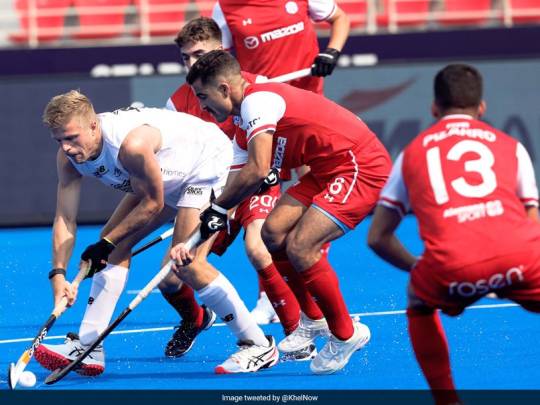
View On WordPress
0 notes
Photo

"The Hollow Road"
by Cornelis Huysmans Flemish, 1648-1727
Oil on canvas
Belgium, c. 1700
Cornelis Huysmans was a Dutch Golden Age painter and draftsman, who lived between 1648 - 1727.
The Hollow Road (1685) is one of Huysmans’ most renowned works of art. It portrays a long, winding road with birds and figures in a pastoral setting.
The painting has a unique aesthetic, combining elements of realism, impressionism and fantasy.
Huysmans’ work is often seen as an expression of the era of the Dutch Golden Age, where the Netherlands had flourished economically, culturally and scientifically in the 17th century.
Belgium in the 1700s was a time of social, economic, and political transformation. In the 18th century, Belgium had become a prosperous trading nation, increasing industrial and commercial activity. During this period, the country saw a wave of new philosophical and artistic movements, as well as spiritual, theological, and literary innovations. Cornelis Huysmans' work, "The Hollow Road" is reflective of this era, presenting a fantasy and romanticized view of the pastoral scenery that existed in Belgium during that time.
Always at your service,
AI Art Detective
This blog took 371 OpenAI tokens.
This image and it's meta-data are courtesy of The Art Institute of Chicago's public API, which you can visit here.
0 notes
Text

Portrait of Baroness van Nieuwvliet in a landscape by Philip van Dijk (1680-1753)
#Philip van Dijk#18th century#Netherlands#18th c. Netherlands#mid 18th century#mdp18th c.#early 18th century#undated
48 notes
·
View notes
Text
France labour in dull draw - France 0 Romania 0 Euro 2008. slot online
Raymond slot online believes Group C will go right to the wire after watching his France side labour to a goalless opening draw with Romania.
Les Bleus struggled to break down well-organised and hard-working opposition and now face Netherlands and Italy in a genuine 'Group of Death' with their qualification hopes having taken an early knock.
But after the abject goalless draw in Zurich, Domenech refused to criticise his side and insists their qualification destiny remains firmly in their own hands. He said: "I have been saying since the draw was made, this is a complicated group. "We have two more matches to play and this will be a tough group right until the end. "There are no weak teams. All four of us are going to do everything we can, but we have known that for six months. "Their (Romania's) team is solid, strong and well prepared and it was a difficult match. "I wish we had have won 10-0 and created many chances but this isn't what happened.
"Of course I will be disappointed if we don't go on and qualify but we are taking it step by step."
Meanwhile, Domenech revealed that he hopes to have injured duo Patrick Vieira (thigh) and Thierry Henry (back) available for Friday's meeting with Netherlands.
Dutch cruise to win - Holland 3 Italy 0 Euro 2008.
Two sensational breakaway goals helped Netherlands secure a deserved 3-0 opening Group C victory over Italy.
Ruud van Nistelrooy and Wesley Sneijder found the back of the net within the space of five first-half minutes, before a third from Giovanni van Bronckhorst 11 minutes from time provided the icing on the cake for Marco van Basten's much-fancied side.
Both teams were hoping to avoid defeat to keep their hopes of qualifying from a difficult group also containing France and Romania alive.
But Italy, without the services of captain and defensive cornerstone Fabio Cannavaro through injury, were always on the back foot against the attacking endeavour of the rampant Dutch.
Italy had a warning in the 18th minute when van Nistelrooy took the ball around Gianluigi Buffon and opted not to go down despite contact from the keeper before finding his angle too acute for a shot.
But eight minutes later, the Real Madrid striker was his normal ruthless self as he poked home a simple chance after van Bronckhorst had fired the ball back into the six-yard box.
Van Nistelrooy was clearly offside when he slotted home and even he looked a little embarrassed as he ran away to celebrate while looking over his shoulder at the assistant referee who stood motionless and refused to raise his flag.
But while the first goal was questionable, the second four minutes later was right out of the top drawer.
Van Bronckhorst was is in the right place at the right time to clear a glancing header off his own goalline following a corner and the left-back powered up field before picking out Dirk Kuyt inside the opposition penalty area.
The Liverpool striker spotted Sneijder in space on the edge of the six-yard box and his first-time header was squeezed between Buffon and the post with a clinical volley.
Buffon kept his side in the match on the stroke of half-time as he saved with his legs from van Nistelrooy when he was through one-on-one with the keeper.
After the break, Italy slowly began to gain more of a foothold in the game and they went close twice through substitute Alessandro Del Piero with angled shots.
Edwin van der Sar then matched the excellence of Buffon with a stunning one-handed save from Andrea Pirlo's 25-yard free-kick to preserve his side's two-goal advantage.
But much like in the first half, the Dutch sprung out from the back and took advantage of the Italian defence being up the field at the set-piece.
Substitute Robin van Persie spotted Kuyt in space and, after his shot was saved by Buffon, the Liverpool forward had the presence to pick out van Bronckhorst with a cross and Gianluca Zambrotta was unable to keep his close-range header out of the net with some desperate goalline defending.
In the final ten minutes, substitute Ibrahim Afellay rattled the crossbar with a shot from 15 yards and by the end a clearly rattled Italy were desperately hoping for the full-time whistle to put them out of their misery.
0 notes
Text
Landscape painting
Landscape painting
Paintings based on landscapes. Sometimes people and animals are also painted as point scenes. The landscape paintings in Chinese painting are actually landscapes.
A painting based on a landscape. Sometimes people and animals are also painted as point scenes. The landscape paintings in Chinese painting are actually landscapes. https://painting-portrait.com/
But it doesn't use the concept of landscape painting. The term landscape painting was introduced into China about the 20th century. In China, it is only used in paintings introduced from the West, such as oil painting and watercolor
Painting, etc.
Whether in the West or China, landscape was only used as the background of figure painting at the beginning, and then gradually developed into an independent painting department. In the West, before the 14th century
Half a leaf of Italian frescoes, such as the Good Government Map of Siena's Town Hall, and the early 15th century Netherland Codex decorative paintings, already have landscapes in them
A work with a heavy weight on the surface. Pure landscape paintings without figures first appeared in the form of sketches and other small pictures. Since the 15th century, the landscape has been transformed from
As the background of the figure painting and become independent painting. In the watercolor paintings of the German painter A. Durer and the oil paintings of A. Altdorfer, it can be seen
Fixed painter foothold of the geographical landscape painting. Landscape painting matured artistically in the Netherlands in the 17th century. J. Vanrisdahl, J. Vermeer, M. Hobema
The development of landscape painting has made great contribution. At this time, from the landscape painting produced seascape painting, night painting, street painting and other branches. A. Karachi et al., Italy
At that time also developed the "ideal landscape painting", presenting pastoral landscape.
N. Poussin and Claude Lorraine of France configured ancient mythological figures as sceneries in landscape paintings, known as heroic landscape paintings. Claude Lorraine used the inverse
Light shows character in a morning or evening scene. In Spain, El Greco and D. Vellas both left famous landscape paintings.
In the 18th century, J. Constable appeared in England, making landscape painting a decisive development. He studied the landscapes of the Dutch painters, which described nature directly
His sketching attitude soon influenced the French impressionists. J.M.W. Tyner was also influenced initially by Dutch painters, and later by Claude Lorraine's
The painting style attracts. Painters in the 19th century also paid attention to the mountains, the sea, late autumn, morning fog and other natural scenes that had never been depicted before. After C. Corot, J.-F. Meter
The Barbizon School in France, led by Lay, began to adopt a naturalistic attitude to express the landscape. In the late 19th century, thanks to the efforts of impressionist painters, the wind
Jing painting obtains the subtle harmony of light, shade and color, and becomes an important category of painting. The Russian painter KnOPkey Shishkin made a lifetime portrait of the universal tree, regarded as a Russian
Founder of the Roth school of landscape painting. Knop.knop.levitan's landscape paintings deeply revealed the suppressed social emotions at that time, which was called the Russian historical landscape paintings. day
This painter Dongshan Kuiyi both learn Eastern and Western tradition, in its rich philosophy of the landscape is permeated with the national mood. After Western painting was introduced into China, Chinese oil painting
Family generally take figure painting as the main subject, followed by dabbling in scenery. Yan Wen □ is known as an early landscape painter. Wu Guanzhong's landscape paintings will be oil paintings
The form is integrated with the traditional Chinese painting, and his works are full of national flavor.https://painting-portrait.com/
0 notes
Photo

“Bolshevism Brings War, Unemployment, and Famine”
...In the beginning of August 1917, the Sixth Congress of the Bolshevic Party was opened.
The presiding committee was made up of 3 Russians, 6 Jews and 1 Georgian. On the 23rd October 1917 the historic session of Z.K. (Central Committee) was held. Here the armed revolt was decided upon. For the purpose of taking over the leadership of the revolt a “Political Bureau” and a “War Revolutionary Centre” were established. These political and military centres of the Bolshevic Revolution were made up of 2 Russians, 6 Jews, 1 Georgian and 1 Pole.
In the English “Collection of Reports on Bolshevism in Russia”, which was presented to Parliament in April 1919, by Command of His Majesty, Report No. 6 contains the following: A telegram from Sir M. Findlay to Mr. Balfour (received on 18th September 1918):
“Following is report by Netherlands Minister at Petrograd, 6th September, received here today, on the situation in Russia, in particular as affecting British subjects and British interests under Minister’s protection: . . .
“At Moscow I had repeated interviews with Chicherin and Karahan. Whole Soviet Government was sunk to the level of a criminal organisation. Bolshevics realize that their game is up, and have entered upon a career of criminal madness. . .
“The danger is now so great that I feel it my duty to call the attention of the British and all other Governments to the fact that if an end is not put to Bolshevism in Russia at once the civilisation of the whole world will be threatened....I consider that the immediate suppression of Bolshevism is the greatest issue now before the world, not even excluding the War, which is still raging and unless, as above stated Bolshevism is nipped in the bud immediately, it is bound to spread in one form or another over Europe and the whole world as it is organised and worked by Jews who have no nationality and whose one object is to destroy for their own ends the existing order of things. The only manner in which this danger could be averted would be a collective action on the part of all Powers.”
On the 13th November 1934 the newspaper The Moment, which is brought out at Warsaw and is one of the East European leading Jewish journals, published an article (In No. 260B) which was entitled “Laser Moisséjewitsch Kaganowitsch” (Stalin’s deputy and right-hand man). The article states: “He is a great man, this Laser Moisséjewitsch-he will one day rule over the country of the Czars... His daughter, who will soon be 21, is now Stalin’s wife. . . and he is good to the Jews - Laser Moisséjewitsch. You see, it is good to have a man in one of the key positions.”
Of the so most authoritative functionaries from the Party and State in the highest councils of the U.S.S.R. we find that more than 20 are Jews and only 17 Russians, whereas the percentage of Jews to the whole population of the U.S.S.R. is only 1.8.
The People’s Commissary for the Interior (formerly Tscheka or O.G.P.U.) is the Jew Jagoda. In the Communist International (the “General Staff of the World Revolution”)-the Jew Pjatnitzki plays the most important role.
The leadership of the Bolshevic revolutionary movement in all countries lay and still lies in Jewish hands. In some countries, such as Poland and Hungary, they are in exclusive control of this movement.
In the trial against the Jewish communist Schmelz in March 1935, the Polish Police Commissioner Landébzrski declared as witness that 98% of those arrested in Poland on charges of communistic intrigues were Jews.
The actual leader in the movement for the Bolshevisation of China is the Jew Borodin-Grusenberg.
Therewith we may close the account.
That is Communism with the mask off. That is its theory, its practice and its propaganda. I have given a bald and staid account of facts which have been gathered mostly from official sources; but this account points to a state of affairs which is so terrible and revolting in all its effects that it must shock the average civilised human being. This gospel of “the emancipation of the proletariat from the yoke of capitalism” is the worst and most brutal kind of capitalism that can be imagined. It has been thought out, set afoot and led under the inspiration of the Mammon worship and materialist thought which is incarnated in international Jewry, scattered throughout every country of the globe. It is no social experiment. It is nothing else than a mammoth system for the expropriation and despoiling of the Aryan directive classes in all the nations, and the substitution of the Jewish underworld in their place. Those people who put themselves forward here as the apostles of a new teaching and the liberators of mankind are in reality figures that herald anarchy and chaos for the civilised world.
There is no longer any political question at issue here. This thing cannot be judged or estimated by political rules or principles. It is iniquity under a political mask. It is not something to be brought before the bar of world history but rather something that has to be dealt with by the judicial administration of each country. It must be met with the same ruthless and even brutal means with which it strives to usurp power or hold power in its hands. Here there can be no barganing; because the danger that threatens Europe is acute. Overnight it might break in among the civilised nations of the world and spread universal catastrophe. Those States that make peace with it will soon learn from experience that it is not they who will tame Bolshevism but that Bolshevism will bring them under its heel. It cannot be said that the Komintern has changed its practices. It is and remains what it always was-the propagandist and revolutionary machinery which is avowedly intended to bring about the downfall of the West.
Bolshevism is the declared enemy of all nations and of all religions and of all human civilisation. The World Revolution is now, as always, its acknowledged and proclaimed goal. Stalin himself has said, as the organ of the War Commissariat, “The Red Star”, in January 1935, triumphantly announced: “Under Lenin’s banner, in the proletarian revolution, we shall triumph over the whole world.” And the communist emigrant, Pieck, said at the Seventh World Congress of the Komintern, held on the 28th July this year: “The triumph of Socialism in Soviet Russia proves at the same time that the triumph of Socialism throughout the whole world is inevitable.” On the day before the Congress was held, “L’Humanité” (the organ of the French Communists) greeted it with the outburst: “Long live the Komintern, the General Staff of the World Revolution.”
Traffic with Bolshevism is not possible either on a political basis or on the basis of general principles in life. The acknowledgement of the Soviet Union on the part of the United States has given rise to an increase in communist propaganda, innumerable strikes and general unrest throughout America. The military pact between France and the Soviet Union led shortly afterwards to an increase of communist votes at the municipal elections, in which they won 43 mandates and thus doubled the number of mandates formerly held by them, while all the other parties lost accordingly. The military alliance between Czecho-Slovakia and the Soviet Union led to sabotaging in the army and to an unexpected increase of communist votes at the elections which followed.
Whoever has made pacts with Bolshevism will have reason to rue his act...
—German Propaganda Archive
1 note
·
View note
Text
Schumann resonance shows anomalie! Extraterrestrials gave us a message June 18th 2023!
0 notes
Photo
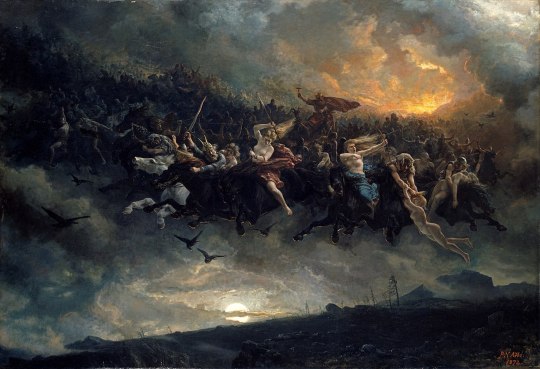

The Wild Hunt [Germanic and Nordic mythology]
Imagine, if you will, a giant tear in the clouds. Suddenly, a band of flying horses breaks through the sky, carrying supernatural riders on their backs. This is the Wild Hunt.
The idea of the ‘Wild Hunt’ is very widespread throughout European mythology and folklore, having counterparts in France, Scandinavia, and Germany, among other places. In Germanic stories, they ride during the Twelve Days of Christmastide, or Rauhnächte. In most versions, the riders are undead humans or the spirits of the deceased. The Wild Hunt is very old: the first written account dates back to 1092 (in the Historia Ecclesiastica). Throughout the ages, new poets and writers added details: some claimed the hunters had a large cart with them, others mentioned a group of dogs accompanying the Wild Hunt.
The hunters are usually being led by Odin, Wodan, Óðinn, Wuotan, etc (they are different versions of the same deity, much like Zeus and Jupiter for example) but this is actually a relatively modern interpretation. Odin only became the leader of the Hunt in the 18th century. Who leads the troupe of supernatural hunters differed throughout time and interpretations. At one point, the Wild Hunt was supposedly organized by the devil and a group of dead spirits. According to 12th century historians, they were being led by Herla, supposedly an ancient king of the Britons (although the character actually originates from Germanic roots). In Lusatia, Germany, it was said that the Wild Hunt is lead by Blauhütl (“blue hat”), the former Lord of Biberstein whose obsession with hunting led him to an afterlife of an eternal hunt.
Yet another, Norwegian version places a female folklore character named Guro Rysserova at the head of the hunting party. Guro’s second in command is Sigurd Svein, a young man. Supposedly, Sigurd was a young bully who enjoyed playing pranks on his friends. One day his mother sent him to the home of her brother, a man named Greip, in his search for his missing father. Sigurd left on his horse, Grani, who was also the son of Sleipnir, and had several adventures (including one where he befriends an ogre). When he arrived at Greip’s house, his uncle told him that his father was dead. The young lad traveled through a swamp and met the Wild Hunt. Guro Rysserova asked him “what do you choose? To be the first in my troop, or to be the last in Heaven?” Sigurd choose the first option and has been by Guro’s side ever since.
The Christian Church interpreted the dead riders as sinners: they are the souls of the unbaptized, those who died of suicide, adulterers, etc. Unable to enter Heaven because of their sins, they are forced to ride the Earth.
In Norway the Wild hunt is often called the Oskoreia (which translates to “the terrifying ride”). In this version, the hunting party consisted of masked riders and they rode between Christmas and the day of Epiphany. Other Norwegian names for the Hunt included Imridn, Fossareia, Trettenreia, etc. The Wild Hunt is malicious, as the riders would break into houses to steal food and drink, and they would empty kegs of beer and fill them with water. It is also said that the hunters stole horses to ride, but they later returned them, which is nice.
Finally, a distinct regional variant of the Wild Hunt arose in Flanders, Belgium (and I am uncertain about this but I think it also spread to the Netherlands). There it was called the Tilkensjacht, and instead of a group of spirits or warriors it was a troupe of female witches. They soared through the sky but were usually invisible. You could hear them approaching from a long distance, however, as they would scream and sing and bang metal objects together to make noise.
Sources:
Lecouteux, C., 2016, Encyclopedia of Norse and Germanic Folklore, Mythology, and Magic.
Kvideland, R. and Sehmsdorf, H. K., 1988, Scandinavian Folk Belief and Legend, Norwegian University Press.
Peeters, K. C., 1981, Vlaams Sagenboek, Davidsfonds, Leuven.
(image source 1: “Asgardsreien” by Peter Nicolai Arbo. I found that this painting is most often used to illustrate the Wild Hunt in modern times)
(image source 2: “Der wilde Jäger”, illustration for “Das festliche Jahr in Sitten, Gebräuchen und Festen der germanischen Völker” by Otto von Reinsberg-Düringsfeld, 1863)
#Nordic mythology#Germanic mythology#Wild hunt#the wild hunt#mythology#myths#mythical creatures#undead
124 notes
·
View notes